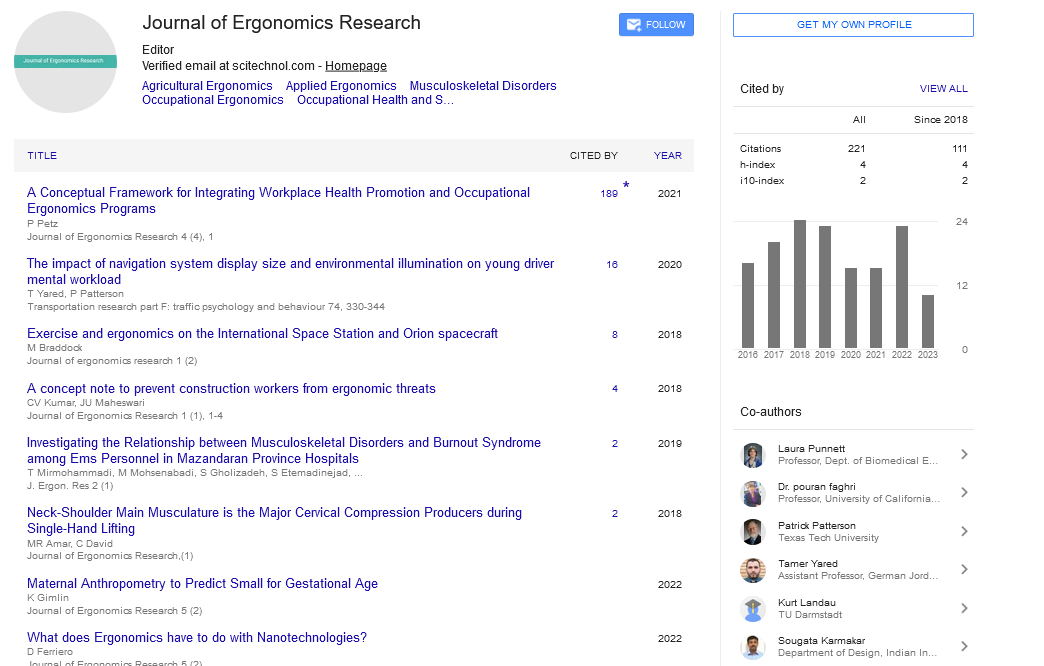Editorial, J Ergon Res Vol: 1 Issue: 2
Job Design in Industry 4.0
Kurt Landau*
Department of Ergonomics and Human Factors, Darmstadt University of Technology, Germany
*Corresponding Author : Kurt Landau
Department of Ergonomics and Human Factors, Darmstadt University of Technology, Germany
Tel: 06151 16-23100
E-mail: sek@iad.tu-darmstadt.de, office@ioa-online.at
Received: November 24, 2018 Accepted: December 15, 2018 Published: January 09, 2019
Citation: Landau K (2019) Job design in industry 4.0. J Ergon Res 2:1.
Abstract
For some years now the debate on the subject of Industry 4.0 has focused on technical improvements in job design expected to yield gains in productivity and profitability and on the whole question of the future of work performed by human beings. Industry 4.0 has become a catchword describing developments in automation and digitalization involving automated objects – products, machines and other industrial equipment, especially items used in the logistics sector. These objects belong to a so-called cyber-physical system (CPS). This
Keywords: Human beings, Industry 4.0
For some years now the debate on the subject of Industry 4.0 has focused on technical improvements in job design expected to yield gains in productivity and profitability and on the whole question of the future of work performed by human beings. Industry 4.0 has become a catchword describing developments in automation and digitalization involving automated objects – products, machines and other industrial equipment, especially items used in the logistics sector. These objects belong to a so-called cyber-physical system (CPS). This system consists of sophisticated networked elements, which can be either physically present at the workplace or located in a Cloud. Thus, Industry 4.0 is definable as a sophisticated network of tangible objects, sensors, computer technology and Man. Processing companies and also service companies are integrating with customers and suppliers to form value-added chains in the hope that these will help to streamline work processes and yield greater flexibility in reaction to changing customer needs, as well as cost savings and competitive advantages. It is still too early to judge whether this can be heralded as the beginning of a fourth industrial revolution. Up to now it has been mainly the technical and economic aspects of this development that have been described and evaluated, but there has also been a certain amount of sociological discussion which has naturally been limited by the lack of available statistical data. Ergonomic debate on this phenomenon is more or less non-existent, despite the fact that it obviously raises questions of changes in job demands, qualifications and stresses and the spectre of ‘ghost’ factories almost devoid of human presence. Understandably, the people still working in present-day factories want to hear some answers to these questions. It must be admitted that Industry 4.0 is not a clearly defined concept complying with a strict specification. There are several large areas where factory-specific solutions are needed. Although forecasts prophesying massive job losses need to be rechecked, it seems likely that some major shifts in job qualifications will be unavoidable [1]. However, this is not surprising, coming as it does after several decades of digitalization in which similar trends towards this type of shift have already been observed. There are strong indications that the existing trend towards polarisation will accentuate – in some cases creating demand for an increasing number of highly qualified production engineers and software technicians, in others for a similarly growing number of unskilled workers performing highly repetitive routine manual jobs which are resistant to automation [2]. In contrast, demand for the ‘middle field’ of less qualified specialists and semi-skilled workers will shrink in both numbers and significance. Specialist technicians will be needed to repair (the rare) breakdowns in highly automated machine-to-machine relationships. These will have to possess a good technical qualification, backed up by long experience in this kind of work and the necessary gift of intuition enabling them to sense the cause of the trouble. Many publications reporting on lab our market research dispute this polarization thesis and assume that job losses will be inevitable, especially in simple production jobs and also in warehousing and logistics. Most of these and other such forecasts are difficult to validate, because adequate supporting data are lacking. This applies to the well-known Oxford Study, which calculates that it will be possible to automate roughly half of all jobs in the USA, not only in production but also in sales and services [3]. While there is no doubt that Industry 4.0 offers significant areas of room for manoeuvre in the distribution of function relationships between man and machine [4], it will, however, be essential to abandon the ‘romantic’ assumption that it will be possible to give all human beings room to concentrate on genuinely creative activities by transferring all difficult, tiresome and repetitive tasks to machines.
References
- S.Z.B (2010) European Center for the Development of Vocational Training, Skills supply and demand in Europe, Thessaloniki.
- S.Z.B, Brynjolsson E, McAfee A (2016) The second machine age. Work, progress and prosperity in a time of brilliant technologies, New York.
- Frey B, Osborne A (2013) The future of employment: how susceptible are jobs to computerization. University of Oxford, UK.
- Nadeau S, Landau K (2017) Towards dynamic and adaptive allocation of staff in a digital-organized production context: an innovative perspective from work science, J Ergon 7:4.
 Spanish
Spanish  Chinese
Chinese  Russian
Russian  German
German  French
French  Japanese
Japanese  Portuguese
Portuguese  Hindi
Hindi 